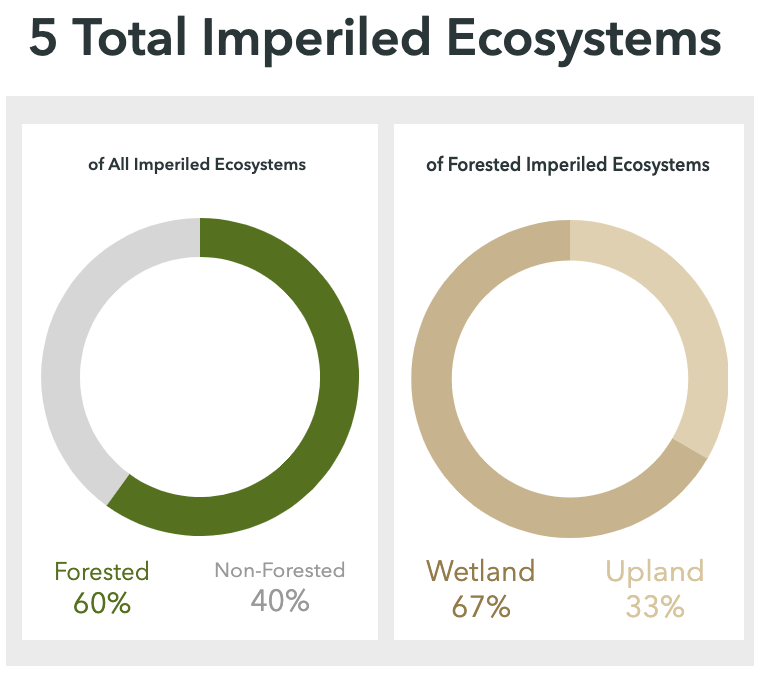Criteria: Imperiled Ecosystems
Data Source: NatureServe
Last Updated: August 2019
WHY IS THIS CRITERION IMPORTANT?
The term ecosystem describes the complex web of interactions between the living community (plants and animal species) and the non-living community (soil, air, water, light). Ecosystems are important because of the ‘ecosystem services’ they provide. These services can be broken down into four main categories: supporting, regulating, provisioning, and cultural. Supporting (or habitat) services refer to fundamental processes like photosynthesis, nutrient cycling, soil formation, habitat provisioning, and the water cycle. Regulating services help to maintain current conditions (those that allow us to live). These include water and air purification, carbon sequestration, decomposition, erosion control, climate regulation, predation, etc. Provisioning (goods or product) services are those that can be extracted, like wood, biofuels, food, medicine, drinking water, etc. And lastly, cultural services refer to the important value ecosystems provide to humans culturally, spiritually, intellectually (science and education), recreationally, and therapeutically1.
For an ecosystem to be classified as imperiled or critically imperiled, it must be at high or very high risk for extinction (collapse), respectively. Conservation and forest management work that restores, protects, and/or improves imperiled ecosystems may help to restore critical ecosystem services and build system resiliency (i.e. ability to withstand and recover from stressors and disturbances) into the future. This criterion helps our members understand where imperiled ecosystems are present and provide context for impact projects.
SUMMARY
 This criterion estimates the number of critically imperiled or imperiled ecosystem types present in the geography of interest. In the Assessment Area Dashboard, we use NatureServe data to report the following information at a Hexagon and Assessment Area level:
This criterion estimates the number of critically imperiled or imperiled ecosystem types present in the geography of interest. In the Assessment Area Dashboard, we use NatureServe data to report the following information at a Hexagon and Assessment Area level:
- Total number of imperiled ecosystem types within the selected geography (NatureServe G1/G2 and IUCN CR/EN)
- Percentage of imperiled ecosystem types that are forested vs. non-forested within the selected geography
- Percentage of forested imperiled ecosystem types that are upland vs. wetland within the selected geography
In doing so, Forests in Focus allows members to visualize how their sourcing areas may overlap with imperiled ecosystems. These areas are associated with ecosystem types that are either naturally quite rare or have faced severe declines in size and condition over time. The healthy functioning of these systems can support important ecological processes and provide habitat for both imperiled and secure species. Being able to identify these areas is a priority in the forestry community.

In many cases, conservation goals (e.g. restoring ecosystems, species, wildlife, and plant habitat, etc.) can complement forest management objectives (e.g. bolstering productivity, supplying fiber, reducing fuel loads, etc.). Take longleaf pine ecosystems for example. They were once dominant across the American South, but are now diminished to a very small fraction of their original range and size as a result of over-harvesting, changes in land use, and a transition to other forest types (e.g. loblolly pine, slash pine, etc.) that are faster growing and don’t require fire for regeneration. Conservation efforts can work to reverse these changes by harvesting and replacing other forest types with longleaf pine stands. Management of longleaf pine forests, including the use of prescribed fire and intermittent thinning (cutting the understory), can help maintain their ecosystem functions and the habitat they provide for other rare, threatened, and endangered species.
| Ranking | Critically Imperiled | Imperiled | Critically Endangered | Endangered |
| Type | NatureServe Global Rank (1-5): | NatureServe Global Rank (1-5): | IUCN Red List of Ecosystems: | IUCN Red List of Ecosystems: |
| Definition | At very high risk of extinction or elimination due to very restricted range, very few populations or occurrences, very steep declines, very severe threats, or other factors.2 | At high risk of extinction or elimination due to restricted range, few populations or occurrences, steep declines, severe threats, or other factors.2 | Considered to be at an extremely high risk of collapse.4 | Considered to be at a very high risk of collapse.5 |
| Rank Symbol | G1 | G2 | CR | EN |
RISK THRESHOLDS
| LOWER RISK | MEDIUM RISK | HIGHER RISK | |
| Imperiled Ecosystems | No known imperiled or critically imperiled ecosystem types present. | Count of imperiled or critically imperiled species that is less than or equal to the national median (2 in a Hexagon or 6 in an Assessment Area). | Count of imperiled or critically imperiled species that is less than or equal to the national median (2 in a Hexagon or 6 in an Assessment Area). |
TECHNICAL INFORMATION
NatureServe is a non-profit organization with a network of over 80 member programs that collect and maintain a unique body of data on the location, condition, and status of plants, animals, and ecosystems. To learn more about NatureServe, visit their website: https://www.natureserve.org/
NatureServe uses globally accepted criteria and guidelines, developed by the International Union for Conservation of Nature (IUCN), to document conservation status ecosystem types across the continental United States. The IUCN Red List of Ecosystems assesses risks to ecosystems based on a common set of criteria. Their system has a total of eight risk categories, and progresses from Collapsed (CO), Critically Endangered (CR), Endangered (EN), Vulnerable (VU), Near Threatened (NT), Least Concern (LC), Data Deficient (DD), to Not Evaluated (NE). A graphic is provided below for reference:6, 7
Similarly, NatureServe assigns global conservation status ranks to ecosystems (or species) which range from Critically Imperiled (G1) to Imperiled (G2), Vulnerable (G3), Apparently Secure (G4) and finally, secure (G5).8 The High Conservation Value Forests criterion only counts ecosystem types that fall into the IUCN Critically Endangered (CR), Endangered (EN) or NatureServe Critically Imperiled (G1) to Imperiled (G2) categories (which are equivalent).
For this criterion, NatureServe used data from remotely-sensed map products and Natural Heritage Program field locations to identify and confirm locations of more than 500 ecosystem types within the lower 48 states. In their analysis NatureServe identified 119 ecosystem types, or 112 terrestrial ecosystems, as threatened (which met the criteria for the IUCN CR/EN rank or NatureServe G1/G2 status).
POSSIBLE DATA AND ANALYSIS LIMITATIONS
The methodology we utilize is designed to support an understanding of the nation’s forest resource and to support observations about trends at different scales. As with any analysis, there are statistical limitations to results, especially at finer scales.
1 The National Wildlife Federation. Ecosystem Services. Website.
2, 3, 8 NatureServe. Definitions of NatureServe Conservation Status Ranks. Website.
4, 5, 6 IUCN. 2016. An Introduction to the IUCN Red List of Ecosystems. Resources – Conservation Tools.
7 IUCN. 2016. Red List of Ecosystems. Website.
